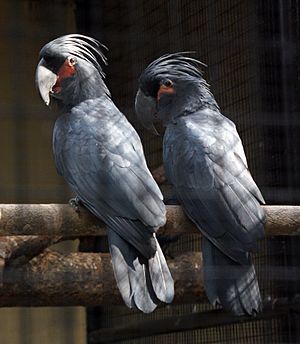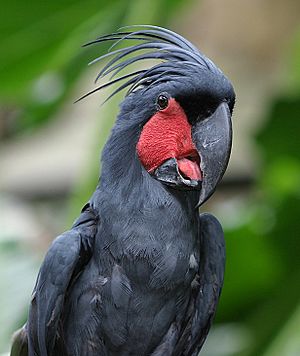Palm cockatoo facts for kids
Quick facts for kids Palm cockatoo |
|
|---|---|
 |
|
| At Melaka Zoo, Malaysia | |
| Conservation status | |
| Scientific classification | |
| Genus: |
Probosciger
|
| Species: |
aterrimus
|
| Subspecies | |
|
P. a. aterrimus [Gmelin 1788] |
|
 |
|
| Australian palm cockatoo range (in green) | |

The palm cockatoo (Probosciger aterrimus) is a large, dark-colored parrot. It is also known as the goliath cockatoo. This bird belongs to the cockatoo family.
In the wild, palm cockatoos eat nuts and fruits from palm trees. They use their very strong, curved beak to crack them open. If they are kept as pets, people feed them different fruits, vegetables, and nuts.
Palm cockatoos live in Cape York Peninsula in northern Australia. They also live in the Aru Islands, Papua New Guinea, and other nearby small islands. These birds are common in these areas. However, scientists think their numbers might be going down. This is because people are using their natural homes for mining. Palm cockatoos are smart birds and can be kept as pets.
Contents
What Do They Look Like?
The palm cockatoo is about 55 to 60 centimeters (21 to 24 inches) long. It weighs between 910 and 1200 grams (2 to 2.6 pounds). It might be the biggest cockatoo species. It could also be the largest parrot in Australia.
This bird is easy to spot because of its large crest of feathers. It also has one of the biggest beaks of any parrot. Only the hyacinth macaw has a bigger beak. This strong beak helps palm cockatoos eat very hard nuts and seeds. Male palm cockatoos also use their beaks to break off thick sticks from trees. They use these sticks for a special drumming display. The male's beak is bigger than the female's.
The palm cockatoo's beak is unusual. The top and bottom parts do not meet for most of their length. This allows the bird's tongue to hold a nut against the top part while the bottom part works to open it. The palm cockatoo also has a red patch on its cheek. This patch changes color when the bird is scared or excited.
Palm cockatoos make many different sounds. These include whistles and even a "hello" call that sounds like a human. Different groups of these birds have their own unique calls.
Some palm cockatoos have lived for a very long time in zoos. One was said to be 80 or 90 years old. The oldest one confirmed lived to be 56 years old at London Zoo. We know how long captive birds live, but we don't know how long palm cockatoos live in the wild.
Where Do They Live?
The palm cockatoo lives in the rainforests and woodlands. You can find them in New Guinea and Cape York Peninsula, Queensland, Australia. They can also be seen near Sorong, West Papua, Indonesia. Sometimes, they are seen in trees along the roads there.
How Do They Behave?
Palm cockatoos have a special way of showing their territory. A bird, usually the male, will hit a large stick or seed pod against a dead branch or tree. This makes a loud noise that can be heard up to 100 meters (328 feet) away. After drumming, the male sometimes breaks the stick into small pieces. He uses these pieces to line his nest.
This drumming behavior was first seen over 20 years ago. But scientists still don't know exactly why palm cockatoos drum. One idea is that females might check how strong a nesting hollow is by the sound of the drumming. Another idea is that males drum to mark their territory against other males. The palm cockatoo is a very old species of bird. It is also one of the few birds known to use tools.
Their Calls and Sounds
Palm cockatoos make calls similar to most wild parrots. But they also make many other sounds when they are showing off or talking to other birds nearby. Males mostly make these extra sounds. They often combine them to make long, complex sequences. In one area called the Iron Range, scientists found 30 different sounds.
How They Live Together
You usually don't see many palm cockatoos together. They don't gather in large groups to eat like many other cockatoo species. Usually, only one to six birds are seen eating together at a time. Like other large birds, both parents take care of their young. So, it's common to see a breeding pair. If these birds do gather, it's usually in open woodland just after sunrise. Or they might gather along the edge of the rainforest before going back to their individual roosts for the night.
Reproduction and Life Cycle
Palm cockatoos lay only one egg every two years. They have one of the lowest breeding success rates of any parrot species. But they make up for this by living for a very long time. A male started breeding at 29 years old in Taronga Zoo in Sydney. A female at the London Zoo was 40 when she laid her first egg in 1966.
They build their nests inside tree hollows that look like standing pipes. Fires are important for creating and destroying these nest hollows. Fires allow tiny living things and termites to enter the tree. These then hollow out the inside. Cyclones are important in the final step of making a nest hollow.
What Do They Eat?
The palm cockatoo often eats in the early morning. Their diet is mostly made up of wild pandanus palm fruit. They also eat nuts from the kanari tree, Canarium australasicum. They have also been seen eating fruit from Darwin stringy bark Eucalyptus tetradonta and nonda tree. They also eat seeds from the cocky apple tree, beach almond, and black bean tree.
Palm Cockatoos as Pets
This bird is very popular as a pet because of its unique look. In the past, pet owners would feed them general bird seed mixes. Zoos would give them special "monkey biscuits." Over the years, we learned more about what they need to eat. Now, owners give them specially made "manufactured diet" pellets. They also get many treats like peanuts, pecans, Brazil nuts, pine nuts, and sunflower seeds. They also enjoy fruits and vegetables such as oranges, apples, grapes, pomegranate, bananas, sweet potatoes, carrots, beets, broccoli, and kale. Many zoos still give them monkey biscuits to make their diet more varied.
Images for kids
See also
 In Spanish: Cacatúa enlutada para niños
In Spanish: Cacatúa enlutada para niños





